Kingfishers of Vietnam – Alcedinidae
With 12 species Kingfishers of Vietnam, occurring over the country. It can be said that this type of bird is the most wanted family that birders all over the world come to Vietnam found to see and take pictures. Two jewels species are Banded Kingfisher and Black-backed Kingfisher appear at the top of any birders wish list.
You may know 12 species in Vietnam although not any species are endemic and not so many species like Plovers family. But you can always see them even when you live in the biggest city in Vietnam because they are one of the highest-density species in Vietnam.
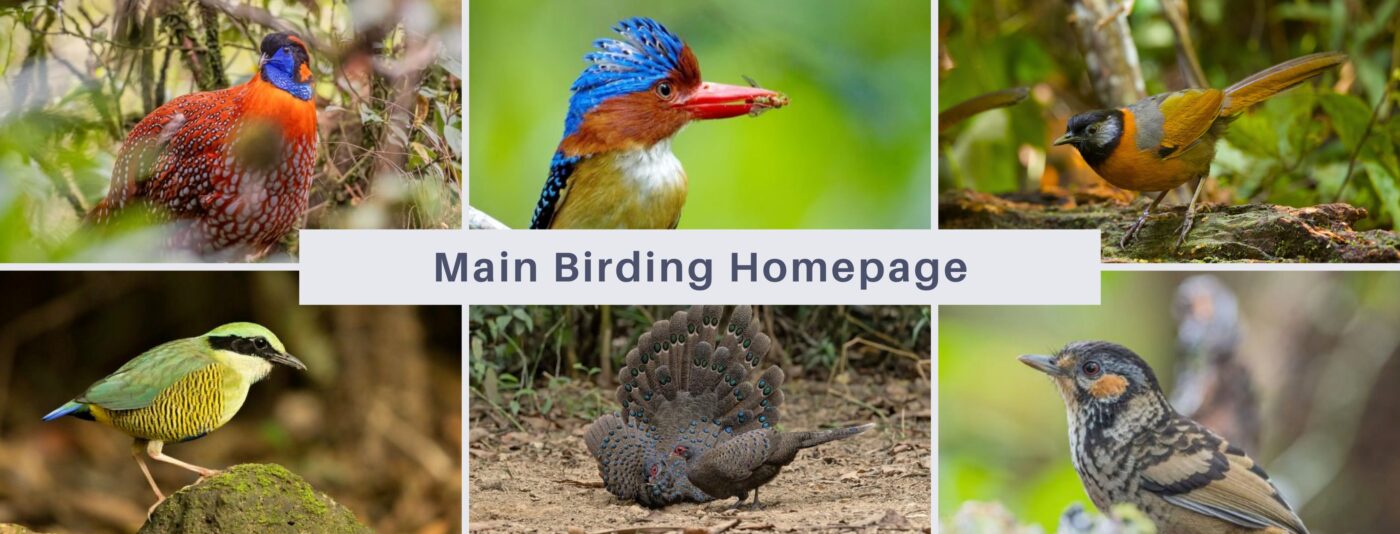
The overview of Kingfishers families
Kingfishers are a family, the Alcedinidae, of small to medium-sized, brightly colored birds in the order Coraciiformes. They have a cosmopolitan distribution, with most species found in the tropical regions of Africa, Asia, and Oceania, but also can be seen in Europe. They can be found in deep forests near calm ponds and small rivers. The family contains 116 species and is divided into three subfamilies and 19 genera. All kingfishers have large heads, long, sharp, pointed bills, short legs, and stubby tails. Most species have bright plumage with only small differences between the sexes. Most species are tropical in distribution, and a slight majority are found only in forests.
They consume a wide range of prey usually caught by swooping down from a perch. While kingfishers are usually thought to live near rivers and eat fish, many species live away from water and eat small invertebrates. Like other members of their order, they nest in cavities, usually tunnels dug into the natural or artificial banks in the ground. Some kingfishers nest in arboreal termite nests. A few species, principally insular forms, are threatened with extinction. In Britain, the word “kingfisher” normally refers to the common kingfisher.
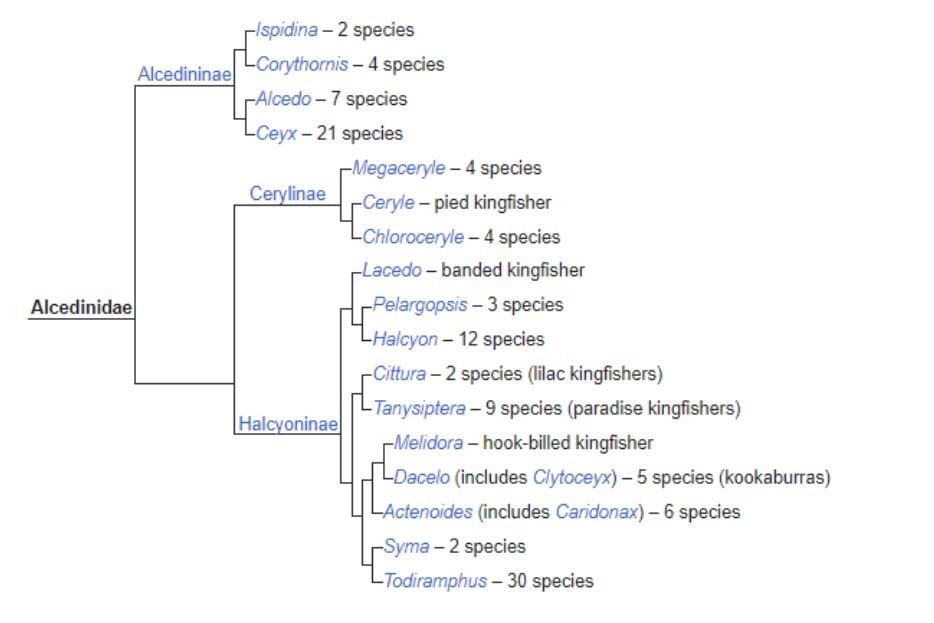
The smallest species of kingfishers is the African dwarf kingfisher (Ispidina lecontei), which averages 10 cm (3.9 in) in length and between 9 and 12 g (0.32 and 0.42 oz) in weight. The largest kingfisher in Africa is the giant kingfisher (Megaceryle maxima), which is 42 to 46 cm (17 to 18 in) in length and 255–426 g (9.0–15.0 oz) in weight. The familiar Australian kingfisher, known as the laughing kookaburra (Dacelo novaeguineae), is the heaviest species, with females reaching nearly 500 g (18 oz) in weight.
The plumage of most kingfishers is bright, with green and blue being the most common colours. The brightness of the colours is neither the product of iridescence (except in the American kingfishers) or pigments, but is instead caused by the structure of the feathers, which causes scattering of blue light (the Tyndall effect). In most species, no overt differences between the sexes exist; when differences occur, they are quite small (less than 10%).
The kingfishers have long, dagger-like bills. The bill is usually longer and more compressed in species that hunt fish, and shorter and more broad in species that hunt prey off the ground. The largest and most atypical bill is that of the shovel-billed kookaburra, which is used to dig through the forest floor in search of prey. They generally have short legs, although species that feed on the ground have longer tarsi. Most species have four toes, three of which are forward-pointing.
The irises of most species are dark brown. The kingfishers have excellent vision; they are capable of binocular vision and are thought in particular to have good colour vision. They have restricted movement of their eyes within the eye sockets, instead using head movements to track prey. In addition, they are capable of compensating for the refraction of water and reflection when hunting prey underwater, and are able to judge depth under water accurately. They also have nictitating membranes that cover the eyes to protect them when they hit the water; the pied kingfisher has a bony plate, which slides across the eye when it hits the water.
You may like: Cat Tien National Park all infomation
Alcedinidae of Vietnam species note
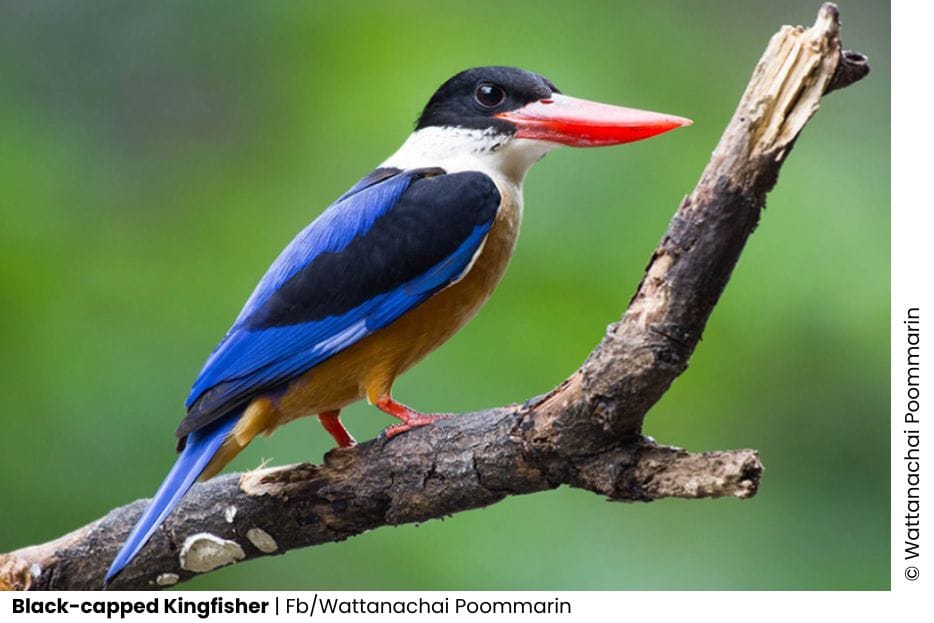
Black-capped Kingfisher Halcyon pileata
Status: Uncommon Pass Migrant – Vulnerable
Best time to watch & Photo: Feb-Apr
Tour cover: Throughout
Hotspot: Tram Chim, Cat Tien, Yok Don
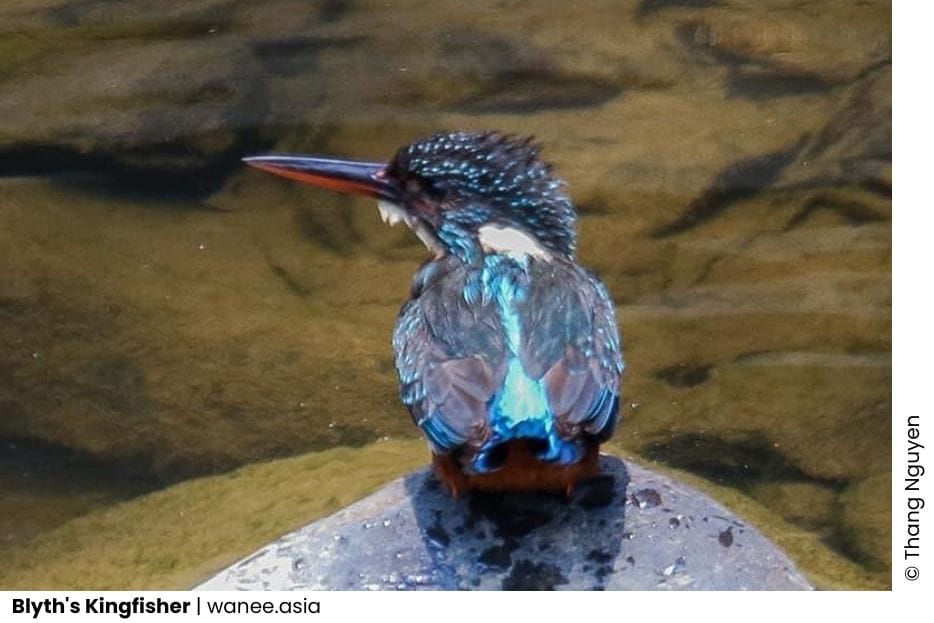
Blyth’s Kingfisher Alcedo hercules
Status: Scarce resident – Near Threatened
Best time to watch & Photo: Feb-Apr
Tours: Central Vietnam
Hotspot: Da Lat Plateau, Bach Ma
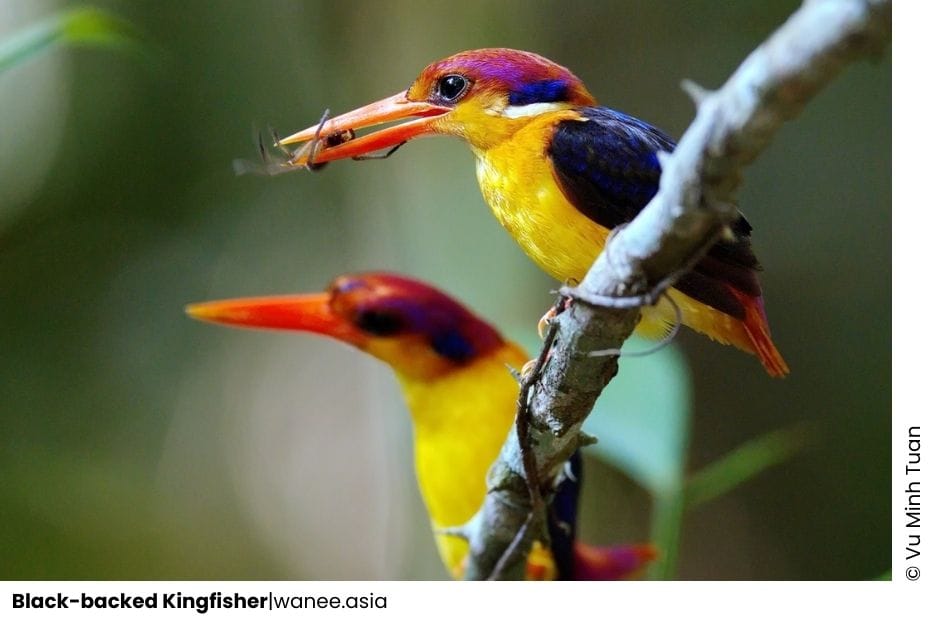
Black-backed Kingfisher Ceyx erithaca
Status: Uncommon resident
Best time to watch & Photo: Feb-Apr
Tours: Exclude Northern Vietnam
Hotspot: Ma Da, Cat Tien, Cuc Phuong
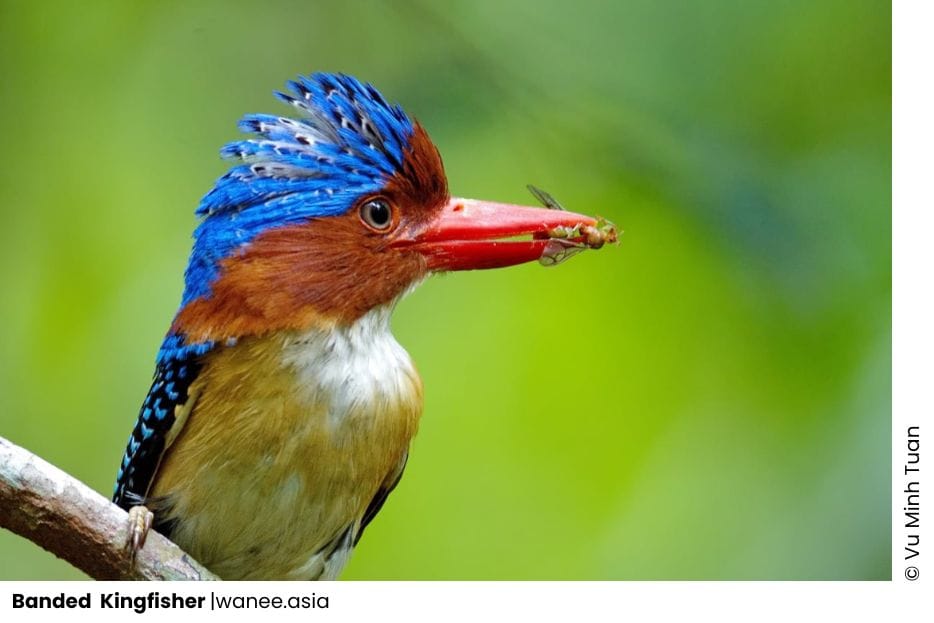
Banded Kingfisher Lacedo pulchella
Status: Uncommon resident
Best time to watch & Photo: Feb-Apr
Tours: South & South of Central Vietnam
Hotspot: Cat Tien, Tan Phu, Da Lat Plateau
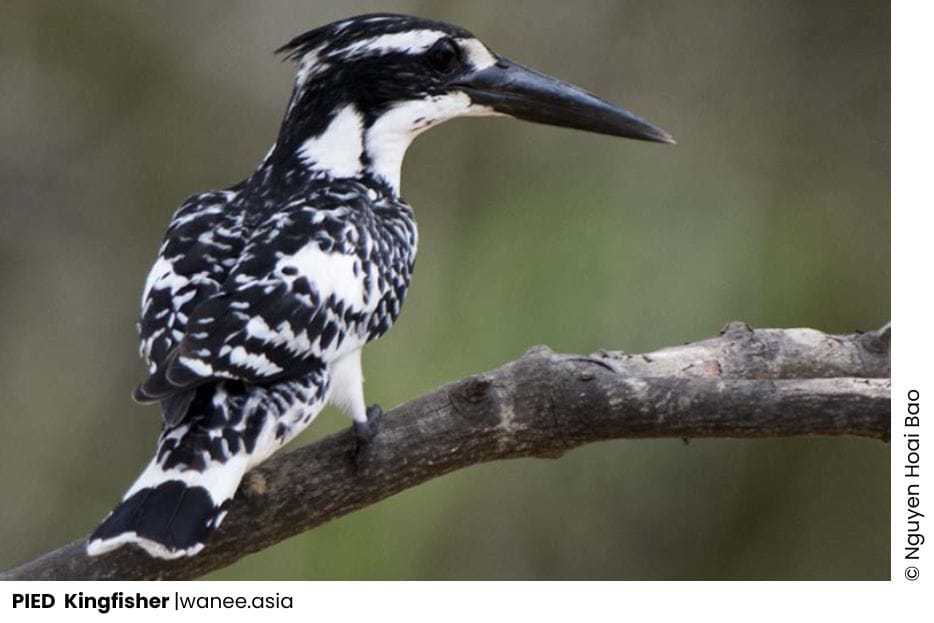
Pied Kingfisher Ceryle rudis
Status: Uncommon resident
Best time to watch & Photo: Feb-Apr
Tours: Coastline Central & South Vietnam
Hotspot: Cat Tien, Bach Ma, Xuan Thuy

Crested Kingfisher Megaceryle lugubris
Status: Common resident
Best time to watch & Photo: Feb-Apr
Tours: Central Highland & Northern Vietnam
Hotspot: Yok Don, Bach Ma, Xuan Thuy
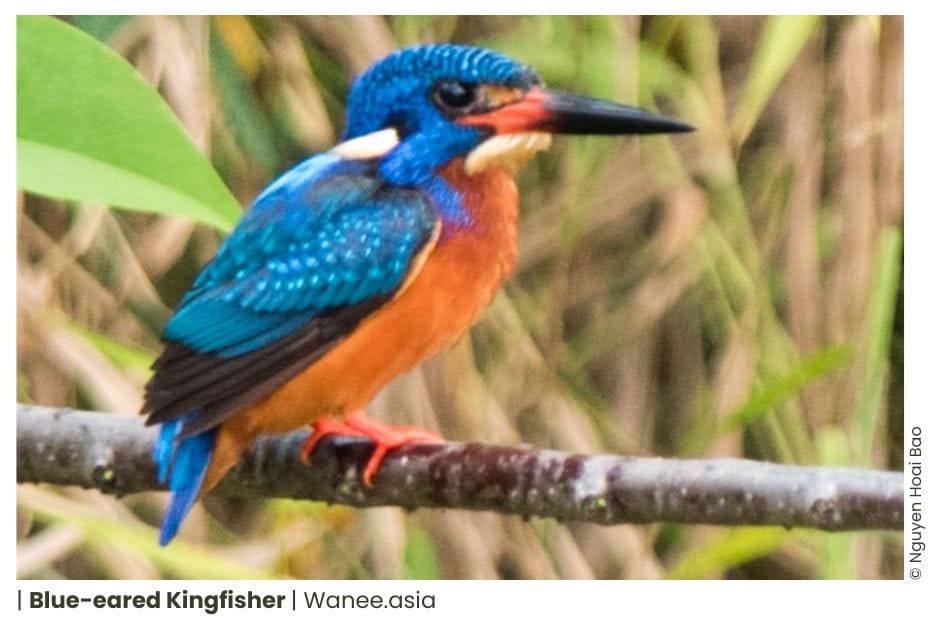
Blue-eared Kingfisher Alcedo meninting
Status: Common Resident
Best time to watch & Photo: Feb-Apr
Tours: Exclude Northern Vietnam
Hotspot: Tram Chim, Cat Tien, Yok Don

Stork-billed Kingfisher Pelargopsis capensis
Status: Common Resident
Best time to watch & Photo: Jun-Aug
Tours: South & South Central Vietnam
Hotspot: Yok Don, Ma Da, Bach Ma

Ruddy Kingfisher Halcyon coromanda
Status: Common Pass Migrant
Best time to watch & Photo: Feb-Apr
Tour: Exclude Highland & Mekong Delta
Hotspot: Cuc Phuong, Xuan Thuy, Cat Tien
List of all Kingfishers in Vietnam
| Name | Level | |
| 1 | Blyth’s Kingfisher | Hard |
| 2 | Common Kingfisher | Easy |
| 3 | Blue-eared Kingfisher | Maybe |
| 4 | Black-backed Dwarf-Kingfisher | Maybe |
| 5 | Banded Kingfisher | Maybe |
| 6 | Stork-billed Kingfisher | Maybe |
| 7 | Ruddy Kingfisher | Lack Data |
| 8 | White-throated Kingfisher | Easy |
| 9 | Black-capped Kingfisher | Maybe |
| 10 | Collared Kingfisher | Easy |
| 11 | Crested Kingfisher | Hard |
| 12 | Pied Kingfisher | Easy |
Note: Hard – Really hard to see; Maybe – …..; Easy – Easy to see with guide; Impossible – Weak info; Lack Data – Consider out of list
All Vietnam Birds Families
Wildlife Tours for Vietnam Kingfishers
At WANEE, we believe that the more we appreciate nature, the more we’ll want to protect it. That’s why our tours are designed to inspire a deeper love for wildlife and a stronger commitment to conservation. While trying harder every day to protect the balance of nature, our wildlife tours give tourists the chance to explore Vietnam’s natural beauty, understand how different habitats connect, and take action to protect them.
Scheduled Wildlife Tours
Tailored Wildlife Tours
Click here to see more tailored tour options
Visit our sites:
– Facebook: WANEE Vietnam (Wild and Nature Exploring)
– Instagram: WANEE Vietnam and WANEE Kids hub
Are you looking for Wildlife Tours in Vietnam?
WANEE VIETNAM is your go-to destination for "Wildlife Tours in Vietnam", specializing in Birding, Primate Watching, Herping, Photography Tours and Educational Tours led by our expert guides.Hot-spot for Birding in Vietnam
all birding in hot-spot informative info [updated Jan 2023]
Nr. Nature reserve; Np. National Park; mt. Mountain
Crocodile Trail – The Best Birding Trail in Cat Tien National Park
If you’re a birder or nature photographer planning a trip to Vietnam, few places offer [...]
Cong Troi Trail – Top 1 Dalat Plateau Birding Trail Experience
If you’re a birder or nature photographer planning a trip to Vietnam’s Central Highlands, the [...]
How to Identify the Greater Sand Plover, Tibetan Sand Plover and Siberian Sand Plover
ContentsKingfishers of Vietnam – AlcedinidaeAlcedinidae of Vietnam species noteAll Vietnam Birds FamiliesWildlife Tours for Vietnam [...]
Highlights of Cat Tien National Park Reptiles and Amphibian Endemics
Spanning over 71,350 hectares of tropical forests, grasslands, and wetlands, Cat Tien National Park is [...]
Highlights of Cat Tien National Park Mammals in a World Biosphere Reserve
In addition to reptiles and birds, Cat Tien National Park is also rich in mammals, [...]
Kontum Plateau Endemic and Highlight bird
Kontum Plateau Endemic And Highlight Bird species like Chestnut-eared Laughingthrush and top birding routes while [...]